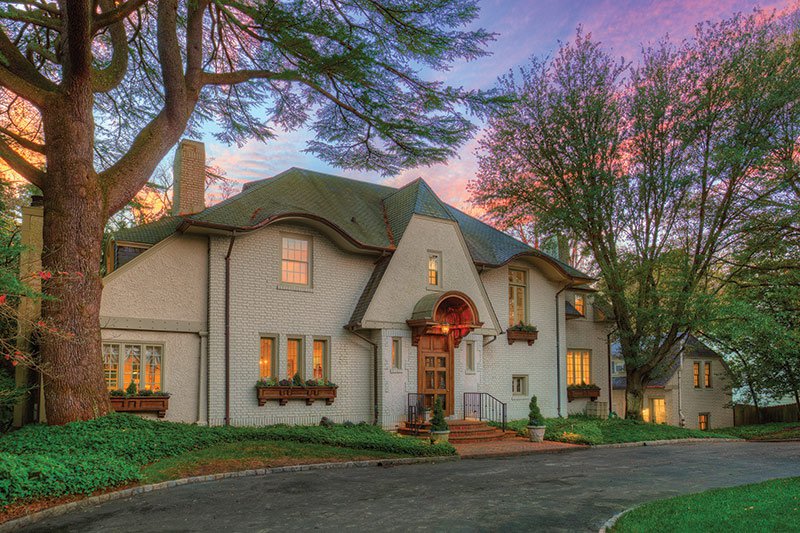Leni Sorensen’s career path has been anything but conventional.

Living by Hand

Garden – Living by Hand
(left) Leni Sorensen’s garden; (right) the tree at left is a Japanese persimmon, and the leafy, upright object is a trellis covered with two hops vines, gifts from friends. Beyond is the chicken house Kip built.

Hens – Living by Hand
Buff Orpington hens.

Eggs and Bread – Living by Hand
(left) Fresh eggs; (right) bread dough.

Bread and Mayonnaise – Living by Hand
(left) Bread fresh from the oven; (right) Sorensen’s mayonnaise.

Lettuce and BLT – Living by Hand
(left) Sorenson cutting ‘Drunken Woman Frizzy Headed’ lettuce; (right) BLT fixings.

BLT – Living by Hand
Sorenson’s BLT.

Sandwich and Sorenson – Living by Hand
(left) The best BLT ever; (right) Leni Sorensen.
It may be a blustery, drizzly Saturday at the tail end of a cold winter—the kind of day for leaving the shutters latched and snuggling more deeply under the covers—but for Leni Ashmore Sorensen, the smell of spring has been irresistible. In fact, she has spent all morning in work boots and fleece overalls, getting ready for the change of season. In the greenhouse, she’s found the cabbage and broccoli seedlings leafing out nicely and long as her index finger. Outside, the Buff Orpington hens that keep her family stocked with fresh eggs and meat peck contentedly at their grain. She’s spent a bit of time on the phone checking the status of various seed orders—and a lot more time walking the grounds at her home in Crozet, a stone’s throw from the scenic Doyle’s River, taking stock of her soil, dreaming up plans for this year’s garden.
At moments like these, tending to her garden and planning the homey projects that bring her such joy, Sorensen seems the quintessential earth mother. But there is a whole lot more to this genial woman than meets the eye. Over the last 40 years, she has invented and reinvented herself—morphing from a counterculture folk singer to midwestern farm wife, back-to-basics foodie and, most recently, into a prominent cultural historian.
These days, Sorensen, 68, is Monticello’s African American Research Historian, an indispensable member of a team working on two extremely high-profile projects. The first is the restoration of Mulberry Row, where Jefferson’s enslaved artisans and house servants lived and worked—a multi-year project involving dozens of people. The second is a first-ever Monticello exhibit at the Smithsonian, scheduled for 2012.
Sorensen, who holds a master’s and Ph.D. from the College of William and Mary, certainly has put in her academic and research time, but her real domain over the last three decades has been the historic house museum, where many visitors have surely encountered her. For years, Sorensen was the woman in a mob cap at Colonial Williamsburg, deftly spinning carded wool into thread while explaining native sources of dye and the science of 15th-century African indigo. She’s whipped up soap at the Museum of Frontier Culture, cheese in the Gunston Hall kitchen and nutritious stews in an iron pot over an open fire on Mulberry Row, regaling onlookers with stories of famed chefs from Mary Randolph to Edna Lewis. Though she’s capable of holding any audience rapt from the podium or with her elegant prose, the most vivid encounters with Sorensen always seem to occur outside: It’s this gift that makes her first and foremost a public historian.
And her profile is growing. Nowadays you can also see her on the television screen with, for example, Walter Staib, the chef and proprietor of Philadelphia’s storied City Tavern. She appeared with him on several episodes of his A Taste of History television series, featuring favorite dishes from Thomas Jefferson’s kitchen prepared in the newly renovated—and fully operational—Monticello kitchen. This weekend’s tour of her garden ends up in her sitting room, where she’s packing jars of seeds, samples and dried gizzards (harvested from her own chickens) for another command performance: a series of lectures and demonstrations centered around Houston’s exclusive Bistro Calais, where Executive Chef Philip Mitchell is hosting a Jefferson-themed meal inspired by recipes from Damon Lee Fowler’s 2003 cookbook Dining at Monticello, as a fund-raiser for the Houston Society of the Archeological Institute of America.
All impressive, but … chicken gizzards? Sorensen gives her full-throated laugh at the quizzical look on her visitor’s face. “They’re for one of just six recipes at Monticello known to be attributed to James Hemings”—Jefferson’s Paris-trained chef and the brother of Sally—“a ‘tea cream,’ or a soft custard, flavored with Jefferson’s favorite Green Yunnan China tea and thickened with a rennet made from the lining of the gizzards,” she explains. She adds, chuckling, “Yeah, I can see you thinking, ‘Yuck!’ But the enzyme in the gizzards was well-known to 18th-century European chefs and would have certainly been a part of James Hemings’ culinary training.”
Indeed, that small moment with Sorensen shaking the jar of gizzards—which, to be honest, look like nothing so much as kettle-fried potato chips—tells one everything one needs to know about her philosophy of food. She has a passion for authenticity, for the tools, the methods, the materials, the techniques used by our ancestors, wedded to the stories that can make them relevant to today. She also subscribes to a hierarchy of tastes in which richness and texture, what she calls “mouth feel,” prevail over the sweets and salts that she believes dull the American palate. One example would be the bitter bite of greens—mustards, collards and kale.
“My mother couldn’t cook—wouldn’t cook,” Sorensen says, so learning was partially a matter of self-defense but mostly a matter of love. “I’ve always loved farmers and been fascinated with what they produced. I always wanted to know—how did that get here? Where did it come from?” As Sorensen was raised amid an extraordinarily rich mixture of cultures, at a time that placed her at the cutting edge of some of the most important historical, social and demographic shifts of the late 20th century, seeking the answers to those questions carried her down some pretty interesting byways.
Born in 1942 in Los Angeles to a mother who was a “Rosie” at the city’s Lockheed factory, Leni Ashmore was a biracial child not just before it was cool but before it was even legal. “My parents had to go to Mexico to get married,” she explains, adding that she was in her 20s before interracial marriages were legalized in the South.
She grew up surrounded by rich food cultures, including those of her Mexican-American and Chinese-American neighbors in California. “There were at that time no more Japanese Americans—they had all been rounded up and interned,” Sorensen notes ironically. Her stepfather, born in New Orleans and bred to cook, was another critical food influence, as were her mother’s mostly Jewish and African American bohemian friends: Holocaust survivors, East Coast expats and Unitarians who flocked to anti-war and anti-nuke causes. Sorensen recalls participating in the first anti-war demonstration on the West Coast—walking 20 miles in a march led by Nobel Prize winner Linus Pauling—and on another occasion riding in the car when her mother drove W.E.B. du Bois, that towering African American intellectual, to the airport.
This background made Sorensen intellectually precocious, but also odd. An 8th grade teacher was scandalized when she turned in a book report on Mein Kampf. “I was always,” she adds with typical understatement, “the kid people were asking, ‘What are you?’”
What she was was an early member of counterculture, and as such she had a firsthand look at the most important political and social movements of the 1960s and early 1970s. When the folk revival began in the early ’60s, Sorensen—trained by Loretta Greene Butler, a dance instructor whose most famous charges were Vivian and Dorothy Dandridge—was in the thick of it. At age 15, she says, “I was San Diego’s first folk singer.” By age 20 she was the opening act for the renowned folkie Josh White as well as an up-and-coming Judy Collins. By 26, she’d spent nearly four years touring with The Womenfolk, a folk quintet based at Greenwich Village’s Bitter End; opened for Bill Cosby in San Francisco; and recorded five albums for RCA. In 1964, The Womenfolk had a hit single named “Little Boxes,” which led to appearances on the Ed Sullivan Show, The Red Skelton Show and The Tonight Show Starring Johnny Carson. Though married with two children, Sorensen even won a juicy role in the West Coast production of Hair, performing under a rigorous dance master and rising star named Ben Vereen.
The British Invasion overwhelmed the Folk Revival and ended Sorensen’s singing career. No matter—her love of good food prepared with the freshest ingredients propelled her into another movement with vast implications for social change: the organic, natural, vegetarian-based foods movement. “I wasn’t a vegetarian myself,” she notes, “but I had very clear ideas about how it should be done—what nutritionally was required, how you could make the food flavorful and healthy.”
By the early 1970s, the home in Laurel Canyon that Sorensen shared with her cinematographer husband and her boys, Kierk and Nikolas, had become the center of a remarkable social scene. There were marvelous dinners for 10, 15, 20 people—singers, dancers, actors, artists all—and Sorensen eventually started an informal cooking school, teaching basic principles of baking (using sprouted grains) and vegetarian cookery. In time, the cooking school became a vegetarian tamale- and tortilla-making concern that, a change of ownership later, is now Tumaro’s Tamales and Vegetarian Entrees.
But long before that business began to pay, Sorensen had changed direction. Drawn by the “back to the land movement,” she moved to Canada and worked for a farmer in northern Ontario, returned to the U.S. to finalize her divorce, then met Kip Sorensen through a personal ad in Mother Earth News. They corresponded for six months, and not long after, in the mid-1970s, she dropped every trapping of her urban, West Coast lifestyle and moved with her sons to South Dakota. There, she reinvented herself as a farmer’s wife, living a self-sustaining lifestyle complete with two more children, Winter and Bjorn, as well as chickens, pigs, a milk cow and a three-acre “garden” to supply the family’s needs. It was an idyllic, eight-year stretch until the farm crisis of the 1980s—the last and the most brutal of her generation’s demographic shifts.
Those of us far from the action vaguely recall a seminal 1985 concert starring Willie Nelson, John Mellencamp and Neil Young. But the help was too little and too late coming for the Sorensens. “In spring 1982, when we went in to re-up on our loan with the Farm Home Administration, we were informed that all agricultural loans below $120,000 were being unilaterally foreclosed,” Sorensen says. It was, she asserts, effectively a government land grab for the benefit of big agriculture. “We could make our crop that year,” she adds, but they could not find a relatively paltry $69,000 to pay off the loan. “We had to get out.”
Faced with such a calamity, the family turned despair into a road trip and set off for Virginia, accepting an invitation to visit friends living in Free Union. In what was to prove the final leg of her west-to-east migration, Sorensen arrived on a Wednesday for a long Labor Day weekend of festivities. By Friday, Kip had struck up a friendship that led to a job offer: building and restoring log cabins. Swiftly considering their options, the couple decided to move to Albemarle County. Kip returned to South Dakota for his tools, and Leni to make the final crop and pack up a lifetime of memories. By mid-December 1982, the entire family was settled near Buck Mountain.
Sorensen, 40 at that time, took full advantage of the change. The woman who’d left high school at 16 to pursue a singing career opted to get an education, something she had long wanted to do. And while doing so, she started working at house museums—at Maymont and Gunston Hall, at Reynolds Homestead, Smithfield Plantation and many others. She enthralled audiences with her skills—soap making, spinning, dyeing, cheese making, open-hearth cookery—and her stories. In those roles, Sorensen was able to weave together the threads of her many lives.
And there are apt to be new adventures. Unsurprisingly, this busy woman is brimming with ideas. She has plans for the team collaborations at Monticello, plans to start classes in cooking and garden-craft, and plans for articles and books telling the stories about food and our ancestors that she finds most compelling.
Right now, though, as a weak spring sun bursts through the cloud cover and floods the rich mahogany earth before her with a golden light, the story that’s foremost on Sorensen’s mind is that of her garden. “And this,” she’s saying, “is where we’ll plant the potatoes. Yukon gold, and red, of course ….”








